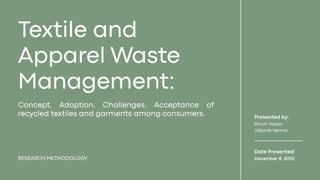Textile and Apparel Waste Management.pptx
- 3. •
- 4. • • • •
- 5. Fast Textile
- 6. Fast Fashion: The fashion industry, and specifically Fast Fashion are one of the key textile waste generation industries. Fast Fashion is one of the most critical factors for leading brands, and its focus is to motivate consumers to buy more clothes. Fast fashion is a business strategy that the main purpose is to make fashion products in short, limited series, minimize cycle and lead times to launch new trends into markets as soon as they become available in order to satisfy customer needs. Fast Fashion retailers have their suppliers produce new items within 3-4 week cycles instead of traditional 10 to 15 weeks (Birwistle and Moore 2010) Sustainable methods Use of organic fibers - Remanufacturing and recycling discarded clothes Reusing second-hand clothes - Producing green products with an eco- friendly process and materials
- 7. Product Life Cycle in Fashion Industry A good understanding of the product life cycle gives more information about the product, and allows organizations to make more accurate production plans, more successful marketing strategies, and more complete financial assessment for investment options (Ultimate, 2015). Consider the five phases of the production process in the clothing lifecycle, from materials, production, transportation, usefulness of product, to the end of life. These five phases are the key factors leading to environmental impacts; therefore it is important to understand how they affect the environment, and how to eliminate their negative effects (Jorgensen, 2013).
- 8. Textile Waste Pre-consumer Textile Waste • Textile swatch waste • Cut and Sew textile waste • End of rool • Sampling yardage • Damaged textile • Clothing sample • Unsold clothing Post consumer Textile Waste Industrial Waste Post-consumer textile waste consists of any type of garments or household textiles that the consumer no longer needs because they are worn out, damaged, or have gone out of fashion. It is generated from industrial applications and includes conveyor belts, filters, geo-textiles and wiping rags. These wastes are by-products of the commercial and industrial textile wastes such as curtains, carpets, etc (Swetlana tonevitskaya, 2019)
- 9. Textile Recycling Recycling is the process of changingwaste material into a new material or product.Textile recycling provides employment, helps charity,avoids the heavy environmental cost of sending thesolid wastes to landfillsand collects clothing for the needy. Textile wastes such as from fibre, textile and clothing canbesourced from the community, manufacturing industry and consumers. The recyclingof waste from textilehelps to conserveresources and reduce the use of landfills. Moreover, the reasonsfor the public’s willingness to participate and economicmarket adoption in recycling should be considered, as publicparticipation is essentialfor effective recycling(Diah, et al., 2012). Besides, the success of the market dependson the customers’ requestsfor recycled goods and the awareness level of the community. 80 percentof the textiles that are thrown away can be recycledand used again,whereas, currently only 25 percent is being recycled.
- 10. • • • • •
- 11. • • •
- 17. ● Variable and the scales of that variable: Age (Nominal) and Willingness to invest in recycled clothing items (Nominal)
- 18. Table 5.5: Chi-Square Test Value df Significance (2-sided) Pearson Chi-Square 4.199^a 2 .123 Likelihood Ratio 3.761 2 .153 Linear-by-Linear Association 3.228 1 .072
- 20. ● Variable and the scales of that variable: Shopping frequency (Nominal) and Frequency of garment disposal (Nominal)
- 21. Table 5.8: Chi-Square Test Value df Significance (2-sided) Pearson Chi-Square 31.640^a 9 .000 Likelihood Ratio 36.880 9 .000 Linear-by-Linear Association 10.235 1 .001 N of Valid Cases 100
- 24. • •
- 26. • • •
- 27. • • • • •
